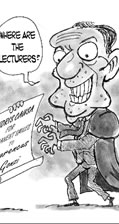This isn’t a direct remake of Roger Corman’s 1975 hit Death Race 2000, but the fundamentals are the same and the film was made in association with Corman.
The setting is 2012 and a bloodthirsty society has made on-line gladiatorial combat big business. One of the more popular ‘games’ is Death Race in which convicts from Terminal Island race against and kill one another.
They drive cars that have been converted into armoured vehicles and are equipped with machine guns and jets that can belch smoke screens, oil, nails and napalm. If anyone wins five races he gets his freedom.
When the most popular driver, Frankenstein, is killed, Terminal Island warden Hennessy (Joan Allen) frames former professional racer Jensen Ames (Jason Statham) for his wife’s murder and makes him replace Frankenstein who always wore a mask.
The film raises expectations right from the moment when Ames gets a verbal introduction to the race and its contestants. The dialogue is clipped and to the point. it’s delivered as a series of punchlines by Ian McShane who gives a standout portrayal of Coach, the veteran expert mechanic who heads Ames’ pit crew.
Female convict Natalie Martinez makes Ames’ navigator, Case, sexy, independent and efficiently lethal while Joan Allen (The Bourne Supremacy/Ultimatum) turns warden Hennessy into a classy villainess. Stratham is his usual reliable self with his raspy voice and menacing eyes.
Writer/Director Paul W. S. Anderson has put all the emphasis where it belongs- on the visual and aural impact of the race sequences. Described on-line as “the ultimate in car carnage,” the races are captured in all their brutality and literally explosive thrilling momentum.
There are overhead shots of warehouses and docks that some of the cars speed through, while on the actual track, the camera duplicates the drivers’ reflexes with whip pans being used to visualise the drivers’ anxious eyes as they dart from one thing to another.
For besides trying to predict and avoid what the driver behind will do next, the drivers must also deal with booby traps that are activated suddenly to turn a car into a wreck of twisted burning metal.
There are several shaky scenes which, admittedly, may temporarily interfere with the visibility, but which replicate the cars’ movements during some of the tougher passages.
The editing must have been a complex and complicated process because it’s extremely fast and many shots don’t last longer than the brief time required for them to register, at which point the editor cuts to something else without losing the continuity.
The race is divided in three stages with some additional sinister obstacle being introduced in the second and third stages. The ending is unexpected but it’s too abrupt to satisfy and the coda raises more questions than it provides answers.
But Death Race doesn’t set out to do anything other than to provide furiously fast, violent, spectacular visceral thrills and amazing stunts. And it delivers that in spades.
George Cuckor’s 1939 film has been updated and turned into the silly, prejudiced and hysterical kind of feminist propaganda. The original was, in turn, based on a play and it certainly shows because of the voluminous amount of dialogue.
Unfortunately it’s mostly trivial dialogue and the film’s scrap of plot isn’t dealt with before a boring waste of about two thirds of its very overlong one hour and 54 minutes.
Of its quartet of female friends, Sylvia Fowler (Annette Bening) is the dominating editor of a women’s magazine, Edie Coen (Debra Messing) is married and keeps having one baby after another and Alex Fisher (Jada Pinkett Smith) is a writer and a lesbian.
Mary (Meg Ryan) is the last to find out that her husband, Steven, is having an affair with a perfume girl, Crystal Allen (Eva Mendes), at Saks.
The characters are shallow, vain and unlikeable except for Mary but in her only bad performance to date, Ryan tries so hard to make Mary sweet and sympathetic that her obviously laboured performance defeats her until she begins her journey of self discovery.
Bening gives a detailed characterisation but for most of the film, her character is a major annoyance. Coen and Pinkett Smith don’t have characters to play; they’re the pawns of the screenwriter’s brand of gender politics.
Messing’s presence only serves to show that life’s a noisy, hectic mess for a couple who love children and who have lots of them. Pinkett Smith is there just to promote the alleged equality and advantages of lesbian relationships.
The best performances come from the oldest and the youngest actresses but their roles are the shortest. As Mary’s mother, Candice Bergen shines brightly in the scene where Mary tells her of Steven’s affair. Bette Midler’s cameo performance is to be relished for its vitality and wicked humour.
And there’s a star in the making in the sensitive performance given by 14-year-old India Ennega as Mary’s daughter who’s disturbed by her mother’s neglect and then by her parents’ separation and pending divorce.
The Women is the first feature film from TV writer/director Diane English who has abused it to indulge her gender politics with disastrous consequences. Her film doesn’t feature a single male actor.
Mary’s bedroom confrontation with Steven isn’t seen or heard. We only get a brief and second hand account of it as one eavesdropping domestic helper describes it to her colleague. This makes a very self-conscious and grossly disappointing way of (not) presenting what should have been one of the film’s highlights.
The complete absence of men even in the background exterior scenes, including the passersby by in the streets, is stupid, unrealistic and distracts by attracting attention to itself.
English’s “bitching about men” spitefulness is all over the film. One of her worst miscalculations is her depiction of Crystal as a bimbo gold-digger in a concept that’s so stereotyped and antiquated as to be considered primitive and vulgar and it’s a demeaning role for Eva Mendes.








